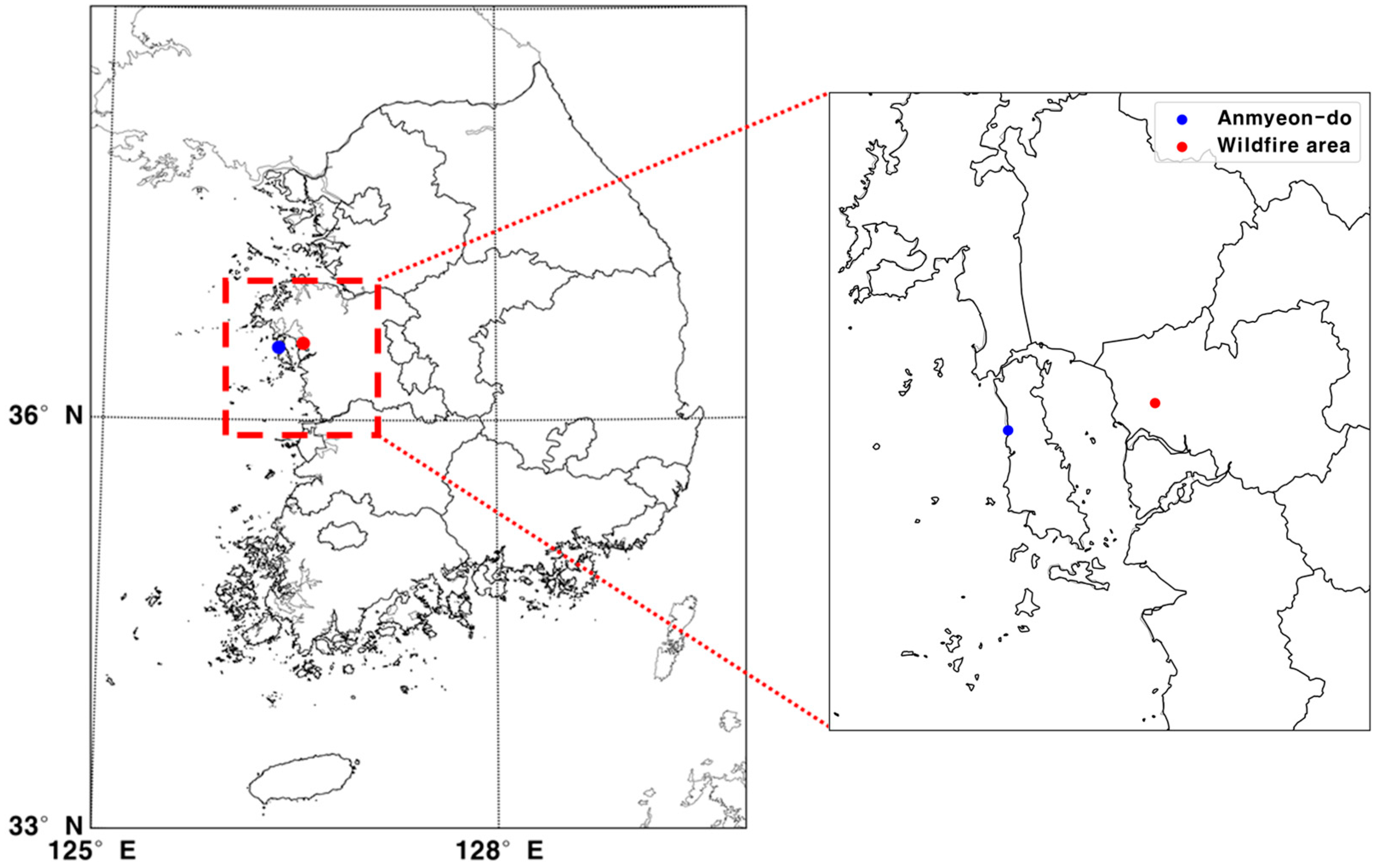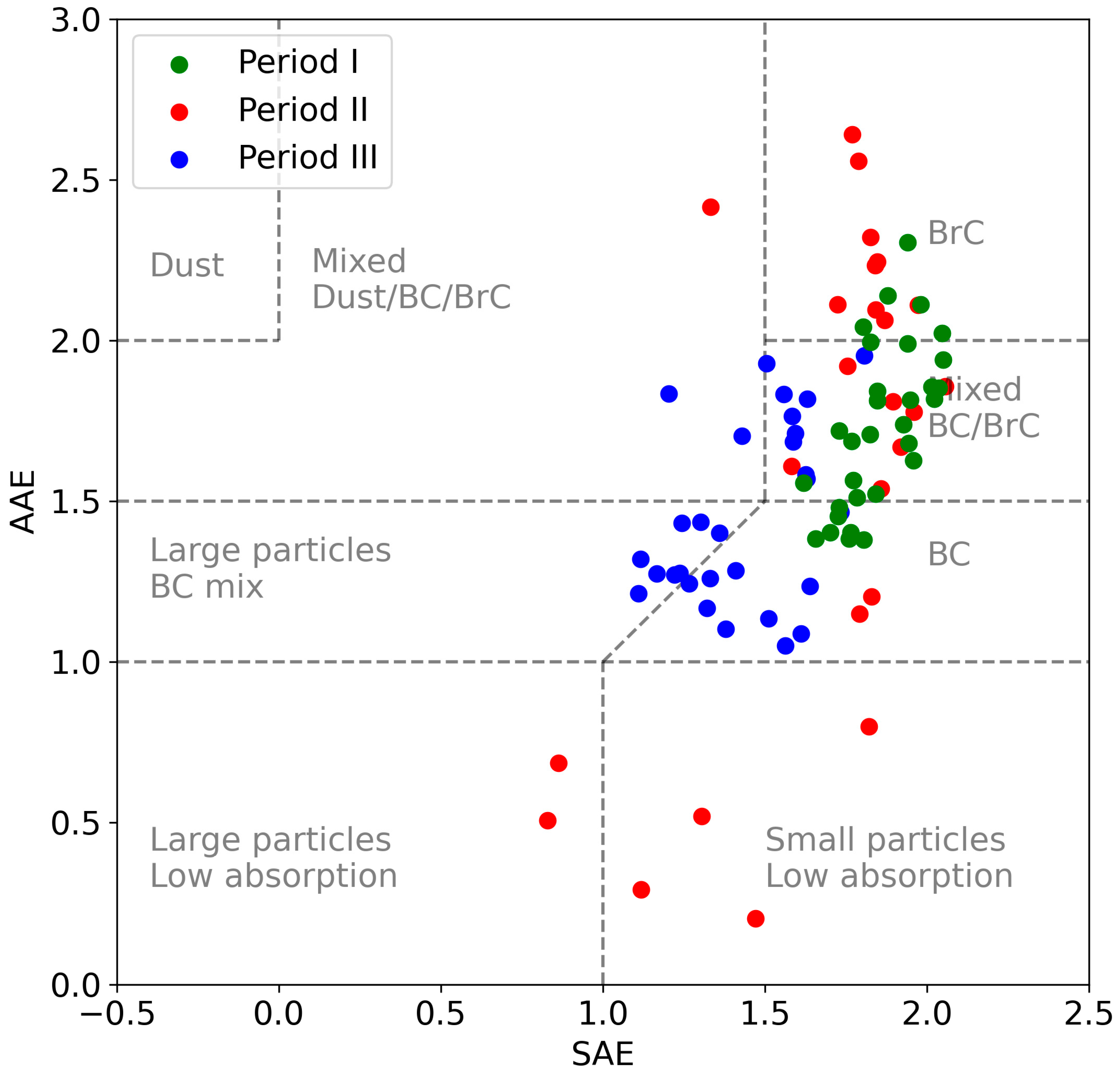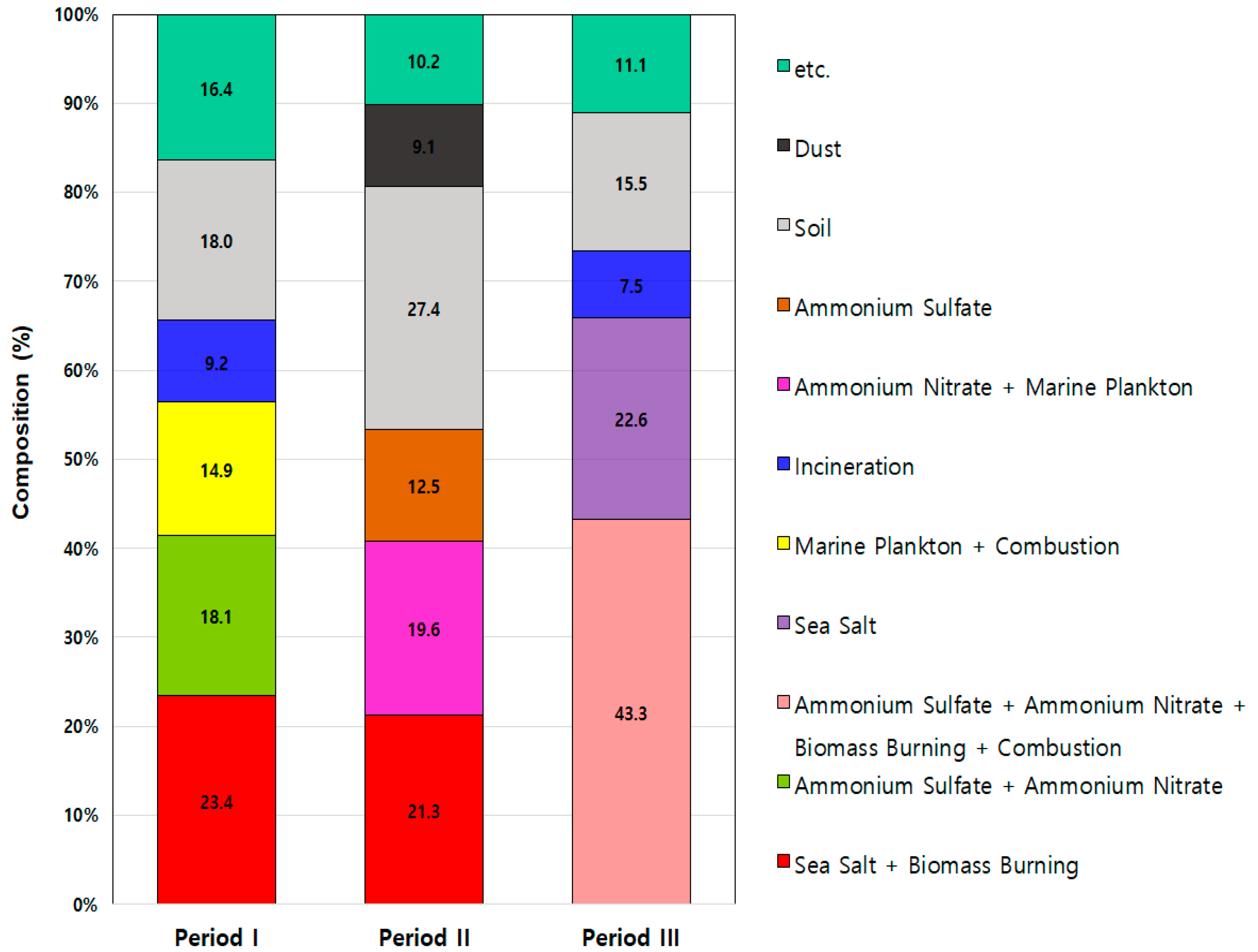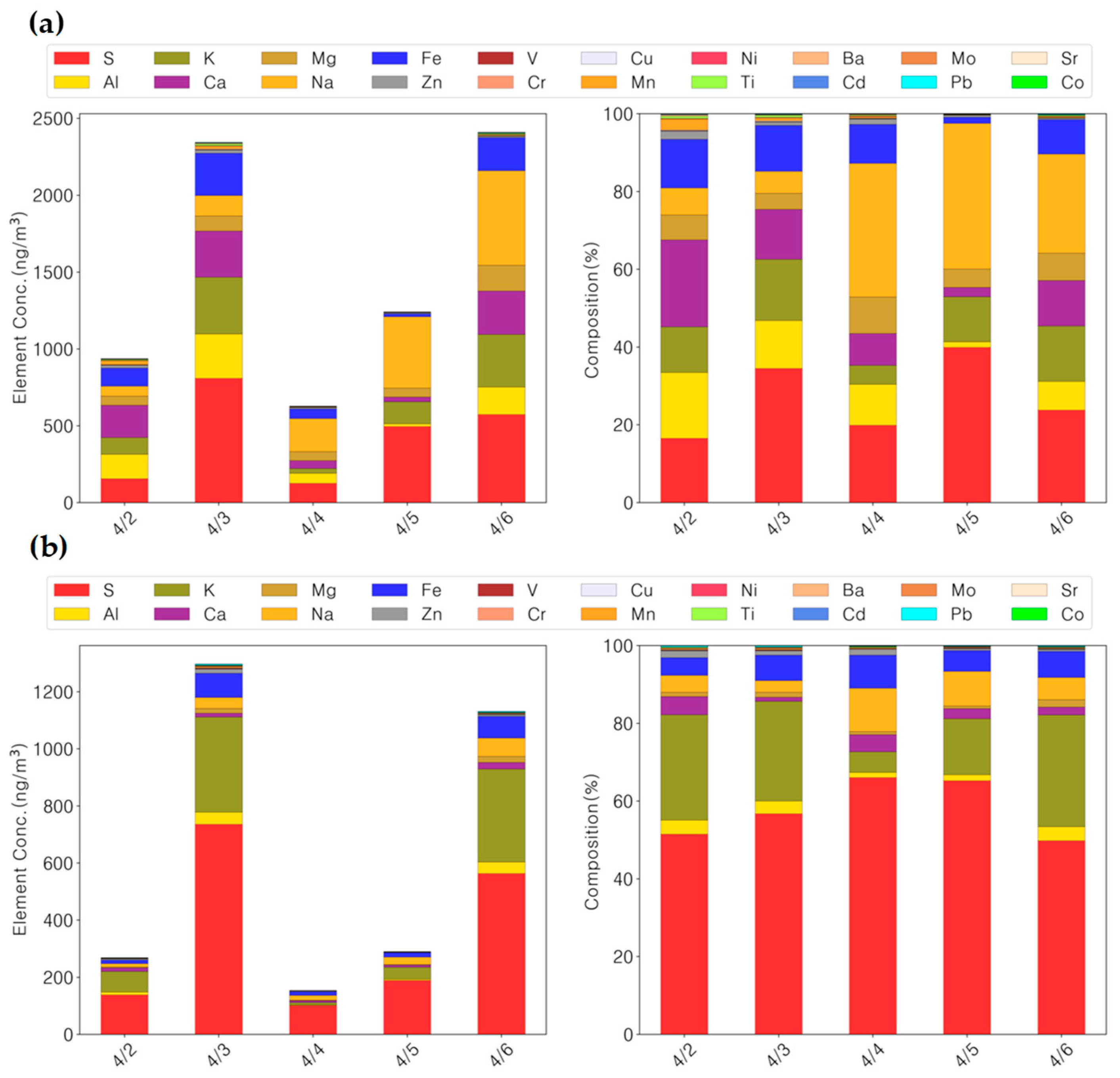Multi-Aspect Analysis of Wildfire Aerosols from the 2023 Hongseong Case: Physical, Optical, Chemical, and Source Characteristics
Abstract
1. Introduction
2. Materials and Methods
3. Results and Discussion
3.1. Aerosol Characteristics by Observation Period
3.2. Classification of Aerosol Types by Period
3.3. Source Apportionment of Aerosols Based on Quasi-Real-Time Analysis
3.4. Chemical Characteristics of Aerosols During the Wildfire Period
4. Conclusions
Author Contributions
Funding
Institutional Review Board Statement
Informed Consent Statement
Data Availability Statement
Conflicts of Interest
Abbreviations
| MARGA | Monitor for Aerosols and Gases in ambient Air |
| PTFE | Polytetrafluoroethylene |
| GAW | Global Atmospheric Watch |
| BB | Biomass burning |
References
- Bu, J.O. Long-Term Variation Characteristics of PM10 and PM2.5 Chemical Composition at Gosan Background Site in Jeju Island. Ph.D. Dissertation, Jeju National University, Jeju, Republic of Korea, 2019. [Google Scholar]
- Rastogi, N.; Singh, A.; Singh, D.; Sarin, M.M. Chemical characteristics of PM2.5 at a source region of biomass burning emissions: Evidence for secondary aerosol formation. Environ. Pollut. 2014, 184, 563–569. [Google Scholar] [CrossRef]
- Sun, D.H.; Song, S.K. Assessment of the impacts of a large-scale wildfire on aerosol composition changes and cloud condensation nuclei. J. Korean Soc. Atmos. Environ. 2024, 40, 689–703. [Google Scholar] [CrossRef]
- Song, J.; Zhao, Y.; Zhang, Y.; Fu, P.; Zheng, L.; Yuan, Q.; Wang, S.; Huang, X.; Xu, W.; Cao, Z.; et al. Influence of biomass burning on atmospheric aerosols over the western South China Sea: Insights from ions, carbonaceous fractions and stable carbon isotope ratios. Environ. Pollut. 2018, 242, 1800–1809. [Google Scholar] [CrossRef]
- Kim, D.Y. Analysis of Air Pollutants Emissions from Biomass Burning in Seoul Metropolitan Area; Gyeonggi Research Institute: Gyeonggi, Republic of Korea, 2011. [Google Scholar]
- Jain, P.; Castellanos-Acuna, D.; Coogan, S.C.P.; Abatzoglou, J.T.; Flannigan, M.D. Observed increases in extreme fire weather driven by atmospheric humidity and temperature. Nat. Clim. Change 2022, 12, 63–70. [Google Scholar] [CrossRef]
- Sokolik, I.N.; Soja, A.J.; Demott, P.J.; Winker, D. Progress and challenges in quantifying wildfire smoke emissions, their properties, transport, and atmospheric impacts. J. Geophys. Res. Atmos. 2019, 124, 13005–13025. [Google Scholar] [CrossRef]
- Descals, A.; Gaveau, D.L.A.; Verger, A.; Sheil, D.; Naito, D.; Peñuelas, J. Unprecedented fire activity above the Arctic circle linked to rising temperatures. Science 2022, 378, 532–537. [Google Scholar] [CrossRef]
- Prasanth, S.; Anand, N.; Manoj, M.R.; Arun, K.; Jose, S.; Satheesh, S.K.; Moorthy, K.K. A new perspective on the genesis of the 2019/2020 Australian bushfire and its atmospheric radiative impacts. J. Atmos. Sol. Terr. Phys. 2025, 274, 106558. [Google Scholar] [CrossRef]
- Deb, P.; Moradkhani, H.; Abbaszadeh, P.; Kiem, A.S.; Engström, J.; Keellings, D.; Sharma, A. Causes of the widespread 2019–2020 Australian bushfire season. Earth’s Future 2020, 8, e2020EF001671. [Google Scholar] [CrossRef]
- Nolan, R.H.; Boer, M.M.; Collins, L.; Resco de Dios, V.R.; Clarke, H.; Jenkins, M.; Kenny, B.; Bradstock, R.A. Causes and consequences of eastern Australia’s 2019–2020 season of mega-fires. Glob. Change Biol. 2020, 26, 1039–1041. [Google Scholar] [CrossRef]
- Chang, D.Y.; Jeong, S.; Park, C.E.; Park, H.; Shin, J.; Bae, Y.; Park, H.; Park, C.R. Unprecedented wildfires in Korea: Historical evidence of increasing wildfire activity due to climate change. Agric. For. Meteorol. 2024, 348, 109920. [Google Scholar] [CrossRef]
- National Institute of Forest Science (NIFOS). Statistical Yearbook of Forest Fire; National Institute of Forest Science (NIFOS): Seoul, Republic of Korea, 2023. Available online: https://forest.go.kr (accessed on 8 March 2024).
- Kim, I.S.; Lee, J.E.; Kim, S.J. The Monthly Environment; Ezengreen Co., Ltd.: Seoul, Republic of Korea, 2025; pp. 14–23. [Google Scholar]
- Sun, D.-H.; Song, S.-K.; Cho, S.-B.; Moon, S.-H. Long-term trend analysis in biomass burning emissions and their impacts on aerosols and CO concentrations in South Korea. J. Korean Soc. Atmos. Environ. 2023, 39, 351–371. [Google Scholar] [CrossRef]
- Kang, Y.; Jang, E.; Im, J.; Kwon, C. A deep learning model using geostationary satellite data for forest fire detection with reduced detection latency. GIScience Remote Sens. 2022, 59, 2019–2035. [Google Scholar] [CrossRef]
- Souri, A.H.; Choi, Y.; Jeon, W.; Kochanski, A.K.; Diao, L.; Mandel, J.; Bhave, P.V.; Pan, S. Quantifying the impact of biomass burning emissions on major inorganic aerosols and their precursors in the US. J. Geophys. Res. Atmos. 2017, 122, 12–20. [Google Scholar] [CrossRef]
- Kang, Y.; Choi, H.; Kim, Y.; Im, J. Understanding the impact of forest fire on ambient air quality. J. Korean Soc. Atmos. Environ. 2024, 40, 103–117. [Google Scholar] [CrossRef]
- Park, E.; Kim, M.-H.; Han, J.; Yoo, H.-J.; Yang, S.-H.; Kim, S.; Kim, Y.-A.; Won, D.; Kim, S.-W. Light-absorption properties of fresh biomass burning aerosols observed at the Anmyeondo Global Atmosphere Watch (GAW) Regional Station: A case study in April 2023. J. Korean Soc. Atmos. Environ. 2024, 40, 614–627. [Google Scholar] [CrossRef]
- Das, S.; Harshvardhan, H.; Bian, H.; Chin, M.; Curci, G.; Protonotariou, A.P.; Mielonen, T.; Zhang, K.; Wang, H.; Liu, X. Biomass burning aerosol transport and vertical distribution over the South African-Atlantic region. J. Geophys. Res. Atmos. 2017, 122, 6391–6415. [Google Scholar] [CrossRef]
- Park, D.H.; Kim, J.E.; Park, J.S.; Choi, J.S.; Kim, S.W. Impacts of the COVID-19 lockdown in China on new particle formation and particle number size distribution in three regional background sites in Asia continental outflow. Sci. Total Environ. 2023, 858, 159904. [Google Scholar] [CrossRef] [PubMed]
- Jeong, M.J.; Yoo, H.-J.; Seo, W.; Shin, D.; Ko, H.-J.; Oh, S.; Chung, C.-Y.; Kim, J.E. Analysis of aerosol characteristics through stereoscopic observation of the West Sea during 2019 YES-AQ campaign. J. Korean Soc. Atmos. Environ. 2022, 38, 823–835. [Google Scholar] [CrossRef]
- Hong, S.-H.; An, M.-Y.; Hwang, J.-S. Impact of road density and vegetation type on large-scale forest fire damage-A case study of the 2023 Hongseong forest fire. Korean J. Environ. Ecol. 2024, 38, 634–645. [Google Scholar] [CrossRef]
- Son, S.-Y.; Lim, S.-H. An analysis of health damage impacts on local residents by type of greenhouse gas caused by 2023 large-scale wildfire in Hongseong. Fire Sci. Eng. 2024, 5, 36–53. [Google Scholar] [CrossRef]
- Anderson, T.L.; Ogren, J.A. Determining aerosol radiative properties using the TSI 3563 integrating nephelometer. Aerosol Sci. Technol. 1998, 29, 57–69. [Google Scholar] [CrossRef]
- Hansen, A.D.A.; Rosen, H.; Novakov, T. The aethalometer—An instrument for the real-time measurement of optical absorption by aerosol particles. Sci. Total Environ. 1984, 36, 191–196. [Google Scholar] [CrossRef]
- National Institute of Meteorological Sciences (NIMS). Report of Global Atmosphere Watch 2023. 2024. Available online: https://nims.go.kr (accessed on 30 June 2024).
- Schmeisser, L.; Andrews, E.; Ogren, J.A.; Sheridan, P.; Jefferson, A.; Sharma, S.; Kim, J.E.; Sherman, J.P.; Sorribas, M.; Kalapov, I.; et al. Classifying aerosol type using in situ surface spectral aerosol optical properties. Atmos. Chem. Phys. 2017, 17, 12097–12120. [Google Scholar] [CrossRef]
- Park, S.; Han, S. Source apportionment of black carbon in PM2.5 observed using a real-time seven-wavelength aethalometer at an urban site of Gwangju. J. Korean Soc. Atmos. Environ. 2022, 38, 653–668. [Google Scholar] [CrossRef]
- Yan, J.; Wang, X.; Gong, P.; Wang, C.; Cong, Z. Review of brown carbon aerosols: Recent progress and perspectives. Sci. Total Environ. 2018, 634, 1475–1485. [Google Scholar] [CrossRef] [PubMed]
- Kang, C.-H.; Kim, W.-H.; Han, J.-S.; Sunwoo, Y.; Moon, K.-C. Pollution characteristics of PM2.5 fine particles collected at Gosan site in Jeju island during 1997~2001. J. Korean Soc. Atmos. Environ. 2003, 19, 263–273. [Google Scholar]
- Vicente, A.; Alves, C.; Calvo, A.I.; Fernandes, A.P.; Nunes, T.; Monteiro, C.; Almeida, S.M.; Pio, C. Emission factors and detailed chemical composition of smoke particles from the 2010 wildfire season. Atmos. Environ. 2013, 71, 295–303. [Google Scholar] [CrossRef]
- Reisen, F.; Meyer, C.P.; McCaw, L.; Powell, J.C.; Tolhurst, K.; Keywood, M.D.; Gras, J.L. Impact of smoke from biomass burning on air quality in rural communities in southern Australia. Atmos. Environ. 2011, 45, 3944–3953. [Google Scholar] [CrossRef]
- Kaskaoutis, D.G.; Petrinoli, K.; Grivas, G.; Kalkavouras, P.; Tsagkaraki, M.; Tavernaraki, K.; Papoutsidaki, K.; Stavroulas, I.; Paraskevopoulou, D.; Bougiatioti, A.; et al. Impact of peri-urban forest fires on air quality and aerosol optical and chemical properties: The case of the August 2021 wildfires in Athens, Greece. Sci. Total Environ. 2024, 907, 168028. [Google Scholar] [CrossRef]
- Oduber, F.; Calvo, A.I.; Castro, A.; Blanco-Alegre, C.; Alves, C.; Barata, J.; Nunes, T.; Lucarelli, F.; Nava, S.; Calzolai, G.; et al. Chemical composition of rainwater under two events of aerosol transport: A Saharan dust outbreak and wildfires. Sci. Total Environ. 2020, 734, 139202. [Google Scholar] [CrossRef]
- Peng, Y.; Suzuki, M.; Nguyen, L.K.; Zhang, X.; Aikawa, M. Presence and source attribution of airborne anthropogenic/non-sea-salt inorganic chloride determined by filter-pack method at eastern edge in East Asia. Water Air Soil Pollut. 2021, 232, 232–238. [Google Scholar] [CrossRef]
- Schlosser, J.S.; Braun, R.A.; Bradley, T.; Dadashazar, H.; MacDonald, A.B.; Aldhaif, A.A.; Aghdam, M.A.; Mardi, A.H.; Xian, P.; Sorooshian, A. Analysis of aerosol composition data for western United States wildfires between 2005 and 2015: Dust emissions, chloride depletion, and most enhanced aerosol constituents. J. Geophys. Res. Atmos. 2017, 122, 8951–8966. [Google Scholar] [CrossRef]
- Wang, Y.; Sun, M.; Li, P.; Li, Y.; Xue, L.; Wang, W. Variation of low molecular weight organic acids in precipitation and cloudwater at high elevation in South China. Atmos. Environ. 2011, 45, 6518–6525. [Google Scholar] [CrossRef]
- Willey, J.D.; Glinski, D.A.; Southwell, M.; Long, M.S.; Brooks Avery, G.B., Jr.; Kieber, R.J. Decadal variations of rainwater formic and acetic acid concentrations in Wilmington, NC, USA. Atmos. Environ. 2011, 45, 1010–1014. [Google Scholar] [CrossRef]







| Properties | Parameter | Instrument |
|---|---|---|
| Physical | PM10 mass concentration | β-ray |
| Particle size distribution | APS (0.5–20 μm) | |
| Optical | Scattering coefficient | Nephelometer |
| Absorption coefficient | Aethalometer | |
| Chemical | Chemical components | IC |
| MARGA | ||
| Trace elements | ICP-OES | |
| ICP-MS |
| Parameter | Period I | Period II | Period III | Anmyeon-do * [27] |
|---|---|---|---|---|
| PM10 mass concentration (µg/m3) | 75.7 ± 31.2 | 19.6 ± 11.4 | 98.2 ± 55.6 | 31.8 ± 13.4 |
| σSC (550 nm, Mm−1) | 307.1 ± 189.6 | 60.1 ± 46.1 | 532.7 ± 391.6 | 77.1 ± 23.7 |
| SÅE (450–700) | 1.9 ± 0.1 | 1.6 ± 0.3 | 1.4 ± 0.2 | 1.5 ± 0.5 |
| σAC (550 nm, Mm−1) | 21.9 ± 15.3 | 3.6 ± 1.6 | 16.8 ± 10.3 | 4.0 ± 2.2 |
| AÅE (470–700) | 1.8 ± 0.3 | 0.8 ± 0.5 | 1.4 ± 0.3 | 0.6 ± 0.4 |
| CO concentration (ppb) | 420.7 ± 242.3 | 174.6 ± 51.9 | 452.2 ± 183.8 | 232.4 ± 50.4 |
| Black carbon (BC) concentration (µg/m3) | 2.3 ± 1.5 | 0.5 ± 0.3 | 2.0 ± 1.2 | 0.5 ± 0.5 |
| Species | Period I | Period II | Period III | |||||||||||
|---|---|---|---|---|---|---|---|---|---|---|---|---|---|---|
| PC1 | PC2 | PC3 | PC4 | PC5 | PC1 | PC2 | PC3 | PC4 | PC5 | PC1 | PC2 | PC3 | PC4 | |
| HF | 0.009 | 0.538 | 0.529 | 0.158 | 0.002 | 0.948 | ||||||||
| MSA (g) | 0.129 | 0.328 | 0.742 | 0.703 | 0.171 | 0.196 | 0.543 | |||||||
| HCl | 0.202 | 0.314 | 0.782 | 0.890 | 0.146 | 0.043 | 0.679 | 0.350 | 0.135 | 0.221 | ||||
| HONO | 0.453 | 0.768 | 0.108 | 0.293 | 0.407 | 0.485 | 0.563 | |||||||
| HNO3 | 0.469 | 0.257 | 0.152 | 0.685 | 0.867 | 0.053 | 0.302 | 0.788 | 0.339 | |||||
| SO2 | 0.252 | 0.449 | 0.383 | 0.032 | 0.615 | 0.775 | 0.182 | 0.006 | ||||||
| NH3 | 0.027 | 0.425 | 0.797 | 0.916 | 0.131 | 0.390 | 0.209 | 0.828 | ||||||
| F− | 0.303 | 0.437 | 0.457 | 0.199 | 0.724 | 0.217 | ||||||||
| MSA− | 0.097 | 0.335 | 0.146 | 0.709 | 0.479 | 0.769 | 0.911 | 0.174 | ||||||
| Cl− | 0.045 | 0.043 | 0.927 | 0.610 | 0.647 | 0.090 | 0.073 | 0.979 | 0.134 | 0.004 | ||||
| NO3− | 0.214 | 0.871 | 0.107 | 0.127 | 0.053 | 0.036 | 0.978 | 0.027 | 0.935 | 0.198 | ||||
| SO42− | 0.155 | 0.843 | 0.142 | 0.163 | 0.070 | 0.070 | 0.957 | 0.091 | 0.948 | |||||
| Na+ | 0.941 | 0.072 | 0.187 | 0.128 | 0.899 | 0.216 | 0.935 | 0.101 | 0.193 | |||||
| NH4+ | 0.911 | 0.145 | 0.053 | 0.141 | 0.877 | 0.430 | 0.964 | 0.104 | ||||||
| K+ | 0.969 | 0.147 | 0.065 | 0.091 | 0.154 | 0.923 | 0.255 | 0.013 | 0.982 | 0.045 | ||||
| Mg2+ | 0.139 | 0.902 | 0.161 | 0.357 | 0.096 | 0.865 | 0.963 | 0.195 | 0.013 | |||||
| Ca2+ | 0.619 | 0.738 | 0.061 | 0.129 | 0.944 | 0.082 | 0.018 | 0.144 | 0.005 | 0.347 | 0.911 | 0.121 | ||
| Eigenvalue | 6.3 | 4.9 | 4.9 | 4.0 | 2.5 | 7.4 | 5.7 | 5.3 | 3.4 | 2.4 | 11.7 | 6.1 | 4.2 | 2.0 |
| Variance (%) | 23.4 | 18.1 | 18.0 | 14.9 | 9.2 | 27.4 | 21.3 | 19.6 | 12.5 | 9.0 | 43.3 | 22.6 | 15.5 | 7.5 |
| Cumulative (%) | 23.4 | 41.5 | 59.5 | 74.4 | 83.6 | 27.4 | 48.7 | 68.3 | 80.8 | 89.8 | 43.3 | 65.9 | 81.4 | 88.9 |
Disclaimer/Publisher’s Note: The statements, opinions and data contained in all publications are solely those of the individual author(s) and contributor(s) and not of MDPI and/or the editor(s). MDPI and/or the editor(s) disclaim responsibility for any injury to people or property resulting from any ideas, methods, instructions or products referred to in the content. |
© 2025 by the authors. Licensee MDPI, Basel, Switzerland. This article is an open access article distributed under the terms and conditions of the Creative Commons Attribution (CC BY) license (https://creativecommons.org/licenses/by/4.0/).
Share and Cite
Bu, J.-O.; Ko, H.-J.; Yoo, H.-J.; Oh, S.-M. Multi-Aspect Analysis of Wildfire Aerosols from the 2023 Hongseong Case: Physical, Optical, Chemical, and Source Characteristics. Atmosphere 2025, 16, 1074. https://doi.org/10.3390/atmos16091074
Bu J-O, Ko H-J, Yoo H-J, Oh S-M. Multi-Aspect Analysis of Wildfire Aerosols from the 2023 Hongseong Case: Physical, Optical, Chemical, and Source Characteristics. Atmosphere. 2025; 16(9):1074. https://doi.org/10.3390/atmos16091074
Chicago/Turabian StyleBu, Jun-Oh, Hee-Jung Ko, Hee-Jung Yoo, and Sang-Min Oh. 2025. "Multi-Aspect Analysis of Wildfire Aerosols from the 2023 Hongseong Case: Physical, Optical, Chemical, and Source Characteristics" Atmosphere 16, no. 9: 1074. https://doi.org/10.3390/atmos16091074
APA StyleBu, J.-O., Ko, H.-J., Yoo, H.-J., & Oh, S.-M. (2025). Multi-Aspect Analysis of Wildfire Aerosols from the 2023 Hongseong Case: Physical, Optical, Chemical, and Source Characteristics. Atmosphere, 16(9), 1074. https://doi.org/10.3390/atmos16091074






